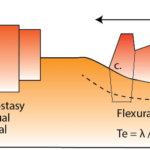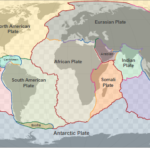
The theory of continental drift was presented by a German geologist, Alfred Wegener in 1910. He suggested that at the beginning of the Mesozoic era (200 million years ago), all the continents of the earth were united together. These continents were united to form a single supercontinent, which he called “Pangaea”. The huge ocean, that surrounded it, he called “Panthalassa”. Wegener proposed that this vast continent began to break up into smaller continents at the beginning of the Mesozoic era, which then steadily drifted to their current positions, just like pieces of wood floating on water. What is Continental Drift?
The continents drifted westward, and equator-ward under the differential gravitational forces. The term “Gondwana Land” was used for the southern huge landmass, which included Africa, South America, Antarctica, and India, while the term “Laurasia” was used for the northern landmass, which included North America, Greenland, and Eurasia. What is continental drift?
To support his theory, Wegener gave much geological evidence, such as similarities in geological structure, distribution of rock types and fossils, and similar shape of coastlines on either side of the Atlantic Ocean.
The theory of continental drift was not accepted for 40 years. It received support only in the 1950s and 60s when geomagnetic pieces of evidence were discovered in its favor. What is Continental Drift?
Evidence for Continental Drift
Alfred Wegener’s hypothesis was continuously rejected by most scientists for 40 years. To prove his theory he persisted to keep on studying Earth’s features, visited libraries, and explored evidence until his death. Wegener never lived to see his theory accepted—he died at the age of 50 while on an expedition in Greenland. Only decades later, in the 1960s, did the idea of continental drift resurface. The most prominent pieces of evidence he found at different locations are as under. What is Continental Drift?
Evidence for Gondwanaland
Similarities in shapes of coastlines: The Atlantic coast of South America and Africa have roughly similar shapes. They would fit in nicely if they were brought in contact with each other. However, the coastlines are not reliable geological features because their shapes change with the rise and fall of the sea level relative to the land. The real edge of the continent occurs at the continental slope, where the sea bottom falls rapidly down to the deep ocean floor. The mapping of the continental slopes of eastern South America and West Africa has indicated that their contours match excellently. This evidence strongly suggests that these two continents were once joined together. What is Continental Drift?
Similar Orogenic Belts: If the eastern coast of South America and the western coast of Africa are fitted together, the orogenic belts of the two continents which have the same range of ages and similar structural trends are found to align themselves across the join. For example, in Ghana near Accra (West Africa), there is a clear boundary between 2000 million years old rocks and the much younger (about 400 million years old) rocks. The same boundary occurs in Brazil (Eastern South America) at Sao Luis. These data provide some of the best evidence supporting their original continuity.
Permo-Carboniferous Glaciation: In the Parana basin in Eastern Brazil (South Africa) glacial deposits of Permo-Carboniferous age are widespread. Their average thickness is about 600 meters. The direction of ice movement that the source area of these glacial deposits lies to the southwest of the present Brazilian coast. In southwest Africa, though the glacial deposits are meager, there is abundant evidence for ice erosion. The direction of ice flow recorded is from east to west. This suggests that South West Africa was covered by an actively eroding ice sheet, which dumped its load further west in Brazil (South America). This evidence proves the original continuity between Africa and South America.
Evidence of Permo-Carboniferous Glaciation has been found in all the continents of the southern hemisphere, such as South America, Africa, India, Antarctica, Madagascar, and Australia. The till deposits and fossil plants found on these continents have been examined and correlated. If these landmasses had always been in the tropical latitude, as they are today. It would mean that glaciation extended from the polar regions to the equator. This idea is apparently, unreasonable. The only explanation for this puzzle is that all these continents were joined together to form a single landmass, Gondwanaland, which was located over the South Pole.
Glossopteris Flora: The remains of the “glossopteris flora” occur in rock beds of the Gondwana Series in South America, South Africa, India, Australia, and Antarctica. These flora reached their maximum development in the Permo-carboniferous period. The nature of their species distribution can only be explained if all the southern continents were joined together. What is Continental Drift?
Land Bridges: To account for the distribution of some plants and animals in the fossil record, land bridges were postulated between the continents. It was assumed that these land bridges disappeared by subsidence. The detailed study of ocean floors in recent years has ruled out this idea. If the existence of Gondwanaland is accepted the distribution of many animals and plants can easily be explained. For example, remains of the reptile “mesosaurus”, which could not have swum on the ocean, have been found in western South Africa and Brazil.
Palaeomagnetic Evidence: Igneous rocks record the earth’s magnetic field present at the time of their formation. A study of fossil magnetism in a region where several volcanic eruptions had occurred on widely separated occasions, has led to an interesting discovery. The orientation of the earth’s magnetic field in each of the separate lava flows is found to be different. This suggests that between volcanic eruptions, the magnetic poles have moved to a new location. Thus palaeomagnetic techniques, which locate the magnetic pole of any stage in the past, give consistent results on each continent only when they are placed in the proposed framework of “Gondwanaland”.
Evidence of Laurasia
Laurasia was the northern landmass, which consisted of North America, Greenland, and Eurasia. The geometrical fit of these continents is quite good. To confirm the existence of Laurasia, geologists have shown the now widely separated Norwegian, Caledonian, Appalachian, and East Greenland mountains were originally formed as a single chain. This match suggests that the northern continents were a single unit sometime in the interval 260 to 70 million years ago.
Position of India
To fit Australia, Antarctica, and India together, geology is used as a guide. The paleozoic mountain belts in Antarctica and Australia indicate how they were joined together. The same pattern of belts also continues into Africa and South America. Further, the edges of Antarctica and Australia at 500 fathoms (1000 meters) line also match nicely. However, there is doubt about the proper position of India. Ahmad, an Indian geologist, has suggested that close links exist between the geology of South East India, and Northwest Australia. He reached this conclusion when he studied the sedimentary basins of the Permian age in these two continents and found them very similar. The main objections for fitting India against northwest Australia are as follows.
- The Upper Carboniferous tillites pattern does not match across the join. What is Continental Drift?
- A recently published fit based entirely on palaeomagnetic data does not support the placing of Inida against northwest Australia.
Thus except for the link between India and Antarctica, there is positive evidence that Gondwanaland existed as a supercontinent until Jurassic time (190 million years ago). If the evidence of seafloor spreading and plate tectonic are added to the argument, continental drift may be regarded as a fact.
Breakup of Pangaea
The chief event of the break up of the supercontinent Pangaea, are as follows;
- Pangaea that existed in Permian times, a little more than 200 million years ago. It was surrounded by a huge ocean called “Panthalassa”. The Tethys Sea existed between Africa and Eurasia.
- The breakup of “Pangaea” began in the Triassic period (about 200 million years ago) with the formation of the rifts. At the end of the Triassic period (about 180 million years ago), the significant features of the geography of the world were as follows.
-
- The North Atlantic Ocean was formed as North America was separated from the African Continent. Due to this, the Tethys Sea contracted.
- The Laurasia was separated from the Gondwanaland.
- A Y-shaped rift was formed in the southern Pangaea, which separated Antarctica-Australia from Africa-South America, and sent India on its northward journey.
-
- By the end of the Jurassic period (about 135 million years ago), South America broke from Africa, thereby forming the “South Atlantic Ocean”. The North Atlantic and Indian Oceans were enlarged but the Tethys Sea continued to close. India moved further northward.
- At the close of the Cretaceous period (65 million years ago), Madagascar was separated from Africa and the South Atlantic Ocean widened. The Tethys closed further to form an inland sea, the Mediterranean.
- About 40 million years ago, India collided with Asia and produced the Himalayan Mountains.
- Greenland has separated quite recently from North America.
You may like to study:


Leave a Reply